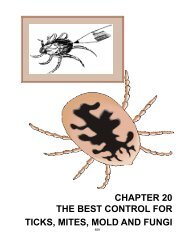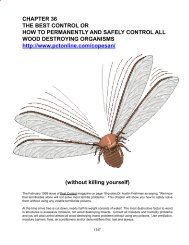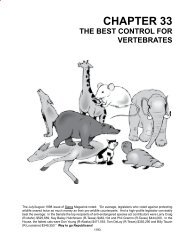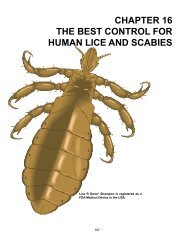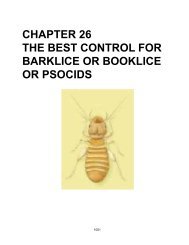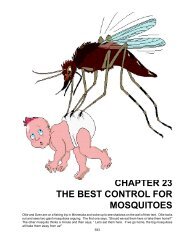CHAPTER 11 - The Best Control 2
CHAPTER 11 - The Best Control 2
CHAPTER 11 - The Best Control 2
- No tags were found...
You also want an ePaper? Increase the reach of your titles
YUMPU automatically turns print PDFs into web optimized ePapers that Google loves.
ut to most people the idea would be disgusting of a toad crawling over anything intended for the table.”Large numbers of the beneficial organism may also be introduced into an area to control a pest. <strong>The</strong>re are severalcommercial companies that specialize in producing beneficial organisms for pest control programs. <strong>The</strong>re is anatural balance outside - leave it alone and you control pests naturally, without any “tools”, costs or dangers!Remember, biological control of pests simply involves the use of one living organism to safely controlanother. Biological controls are sustainable and quite safe!Most arthropod pests have many natural enemies or disease organisms that can often be used to control orsuppress them for free. About 1/3 of all insect species are carnivorous (they eat meat). Some species eatdecaying meat and/or dung or plants, but most carnivorous insects hunt for their food. House centipedes,earwigs and spiders are predators of the pest insects and should be conserved and nurtured. <strong>The</strong>y are calledbeneficial insects. In horticulture and agriculture, there are certain insect predators that may be introducedthat will eradicate or reduce the population of a pest insect or weed to acceptable levels. <strong>The</strong>se insects areoften available commercially. <strong>The</strong>re are many natural parasitoids and microorganisms that can be used to helpcontrol many pests. One of these products is milky spore (disease) which is deadly only to white grubs, e.g.,June bug grubs and Japanese beetle grubs, with no ill effects on earthworms or bacteria. People and pestsare also not effected adversely. Milky spore does need a year to build up killing levels in the soil. Once thislevel is reached, the spore will kill grubs for 20 years. A weevil from South America, Neochetina eichhorniae,helps to control the growth of water hyacinth, an aquatic weed that chokes waterways. A flea beetle from SouthAmerica, Agasicles hygrophila, helps to contain alligatorweed, another invasive plant. A flea beetle from Italy,Longitarsus jacobaeae, the caterpillars of the cinnabar moth from France, Tyria jacobaeae, together suppresstansy ragwort, a plant that takes over U. S. pastureland and is poisonous to cattle. Dung beetles from SouthAfrica help clear pastureland littered with cattle manure in Texas. Horn-faced bees from Japan help U. S. honeybees to pollinate apple orchards. A ladybug from Australia, Rodolia cardinalis, controls the cottony-cushion scale,a pest of U. S. citrus orchards. Note: You can still fertilize and use a fungicide on your lawn, but insecticideswill kill this spore. If you use Nutriganics or organic fertilizers, they will provide your yard with nutrients andrestore the microbial activity. We do not recommend you use “organic” fertilizers that contain human sewage,chlorine or use dangerous synthetic fungicides. You can also purchase gecko lizards, grasshopper semasporebaits, lady bugs, trichogramma and/or fly parasite wasps, lacewings, minnows, nematodes, Bt, praying mantisegg cases, traps or bait stations with the fungi -Metarhizium anisopliae (strain ESFI), owl and falcon decoys,etc. When natural enemies or organisms are already present, try to protect and nourish them so theymay increase in number and attack the pests more effectively, efficiently, safely, and more economicallythan any other control! Professional pest control probably will not utilize biologicals much because they donot stay where they are released, but go elsewhere and do their thing for free. Caution: biological controls donot work quickly - often farmers will release biologicals, still see a few pests after a few weeks and then sprayvolatile synthetic pesticides and kill all their beneficials or “hired killers” in the process. Understand how they workbefore you use them. Remember, you have to leave some “pests” around if you want their natural enemies tostick around and safely help you keep the pests under control. Biologicals need to be registered only when theyhave been genetically altered. When the Author drove through the jungles of Costa Rica, no insects splatteredon his car’s windshield; only here in the U.S.A. where we continually spray volatile, synthetic pesticide poisonsdo the insects splatter his car’s windshield.Biology of the Pest Species - If you know this you can design the proper control(s).Bio Path ® bait stations from Eco-Science - are biological control agents because they contain living organisms(fungus) which virtually eat the roaches or termites.Biopesticides - Natural materials that are used to control pests that are not synthetic chemical (poison) preparations,e.g., fungi, bacteria, viruses and enzymes. Mixed plant compounds lessen resistance and use theheightened control effects that synergism creates.Bird Slopes - Anti-perching and anti-roosting devices. http://www.birdgone.comBird traps and netting (http://www.birdx.com) - will safely control birds without harming them or the environment.<strong>The</strong>y are avisafes.364



